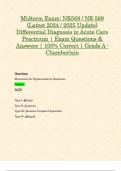Midterm Exam: NR569 / NR 569
(Latest Update)
Differential Diagnosis in Acute Care
Practicum | Exam Questions &
Answers | 100% Correct | Grade A -
Chamberlain
Question:
Mnemonic for Hypersensitivity Reactions
Answer:
ACID
Type I: Allergic
Type II: Cytotoxic
Type III: Immune Complex Deposition
Type IV: Delayed
,Question:
Test to Evaluate Dyspnea
Answer:
- CXR
- EKG
- ABG
- CBC
- CTA
- Transthoracic Echocardiogram (TTE)
- BNP
- Methemoglobin
- Carboxyhemeglobin
- D-Dimer
- PFT
- 6 minute walk test
- CPET
Question:
Infective Endocarditis
Answer:
- An acute or subacute bacterial infection of the endocardium or the heart
valves or both. The condition is characterized by heart murmur, prolonged
fever, bacteremia, splenomegaly, and embolic pneumonia.
,Question:
Acute Bronchitis (Respiratory)
Answer:
- Acute inflammation of the mucous membranes of the tracheobronchial
tree. Pathophysiologically, acute bronchitis increases airway resistance due to
sputum production and airway epithelial inflammation. Patients with acute
bronchitis typically present with cough and sputum production and may have
rhonchi on exam.
- Treatment: Not usually treated with with abx unless the patient has a
preexisting lung condition such as COPD.
Question:
Pneumonia (Respiratory)
Answer:
- An acute inflammation of the lungs, often caused by inhaled pneumococci
of the species Streptococcus pneumoniae. The alveoli and bronchioles of the
lungs become plugged with a fibrous exudate. Pneumonia may also be caused
by other bacteria, as well as by viruses, rickettsiae, and fungi. May increase
airway resistance due to airway edema. May also lead to decreased compliance
of the respiratory system due to regions of lung consolidation. Patients with
PNA will note fever, complex pleuritic chest pain, and rales on exam. An
infiltrate on CXR often confirms the diagnosis of pneumonia.
- Treatment: The mainstays of treatment of PNA are antibiotics and
supplemental oxygen.
, Question:
Aspiration Pneumonitis (Respiratory)
Answer:
- Refers to inhalational acute lung injury that occurs after aspiration of sterile
gastric contents. Has a very similar physiologic mechanism and clinical
presentation to pneumonia, and should be suspected in patients who were
obtunded or have swallowing difficulties due to stroke or other
neuromuscular problems.
Treatment: Although aspiration pneumonitis due to gastric acid does not
need to be treated with antibiotics, most clinicians add antimicrobial
coverage, particularly if there is an elevation in the patient's temperature or
WBCs, as there may be an infectious component due to aspiration of oral or
GI flora.
Question:
Asthma (Respiratory)
Answer:
- A respiratory disorder causing narrowing of the airway that may be due to
allergy or hypersensitivity reactions. It is a complex disorder involving
biochemical, immunological, infectious, endocrinological, and psychological
factors. Patients with asthma often present with complaints of "chest
tightness", a sensation attributed to stimulation of airway receptors, and a
sensation of an "inability to take a deep breath" and "air hunger", which likely
arises from increased drive to breathe and limited inspiratory capacity
resulting from hyperinflation.
Treatment: Includes bronchodilators and steroids.




